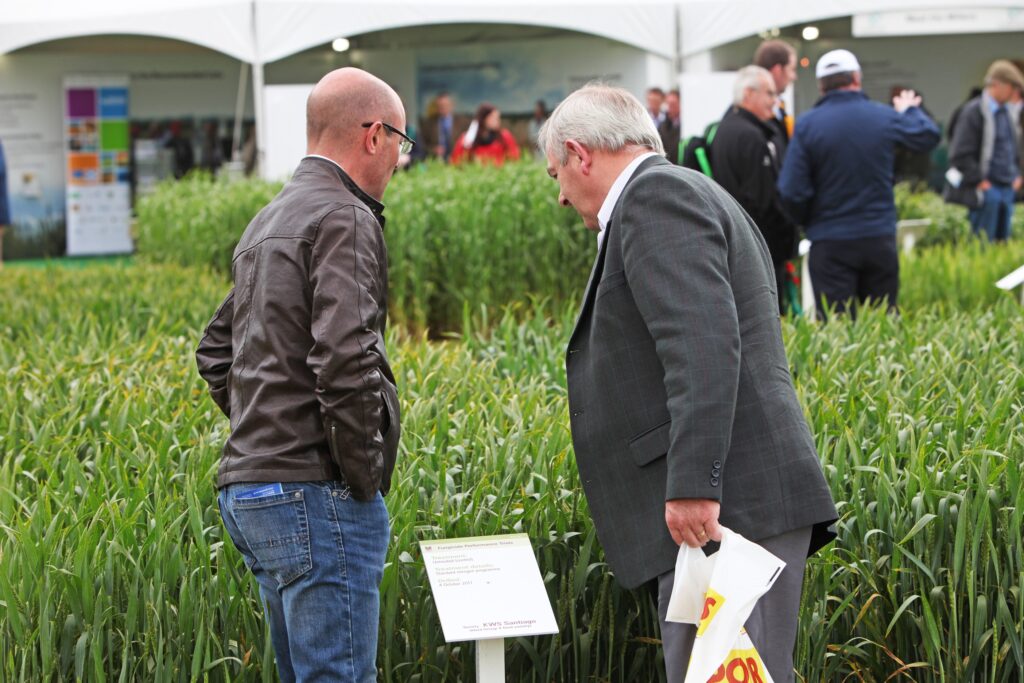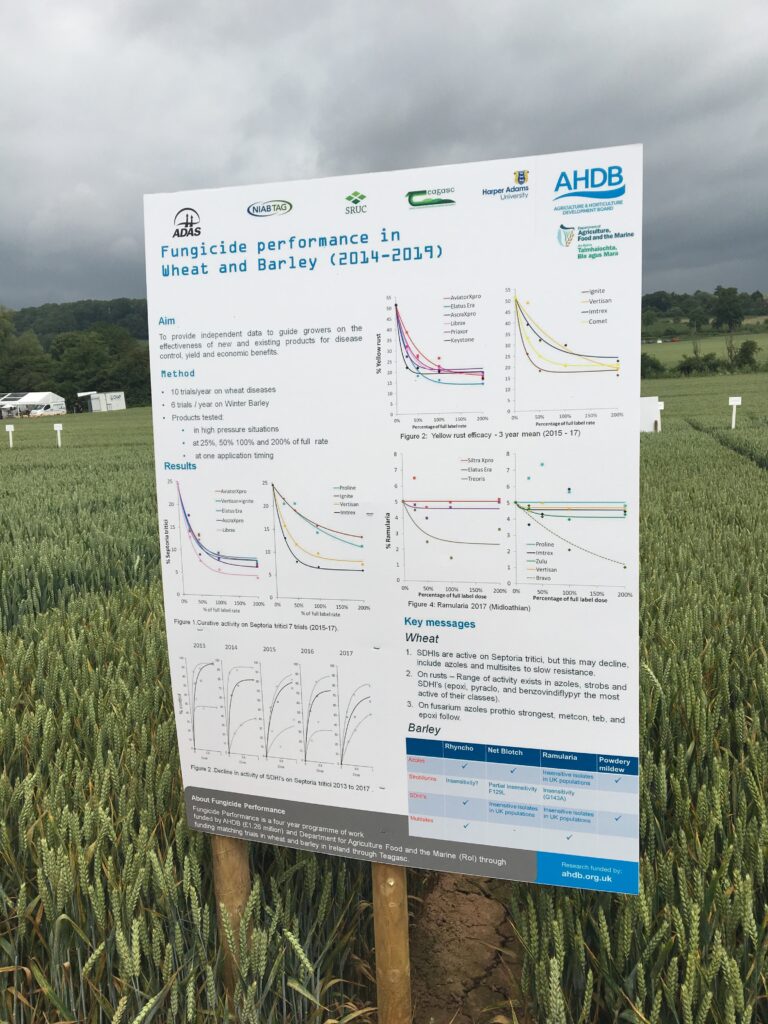AHDB Technical Content Manager Jason Pole explains the role of the fungicide performance information in choosing the best technology to protect crops.
For 30 years, there’s been a trusted team that’s tested the efficacy of chemistry used to battle major crop diseases in the fungicide performance project. The wheat trial series is the oldest, going back 30 years (1994), followed by barley (2002) with oilseed rape introduced in 2006.
Fungicides can make big differences to yield, as illustrated by the yield-pushing protocols in the Recommended Lists (RL) trials. For winter wheat, the current fungicide-treated, five-year (harvest 2019–23) control mean yield is 11.04t/ha, which compares with 8.77t/ha for the fungicide-untreated control mean. Even varieties with relatively high levels of disease resistance, like KWS Extase and Mayflower, show a yield benefit of more than 0.5t/ha from fungicide treatment (on average).
Understandably, many farmers want to drive down input use to optimise return on investment. This is where fungicide performance data can help. It can be used to identify the best products and calculate appropriate doses – in the context of local (and frequently fickle) disease risks. Even if you delegate decisions to the agronomist, fungicide performance data can inform discussions to ensure the approach taken fits in with your farm’s aims.

Trial background
To maximise treatment differences in the trials, the team selects high-risk sites and susceptible varieties to the target diseases, which currently are:
- Wheat – Septoria tritici, yellow rust, brown rust, and fusarium and microdochium
- Barley – rhynchosporium, net blotch, ramularia, mildew and brown rust
- Oilseed rape – light leaf spot and phoma
For cereal and oilseed rape trials, treatments are applied once and twice, respectively. Four doses are used to allow the creation of the classic ‘dose-response’ curves, which generally show how much more disease control and yield uplift is associated with higher doses. The curves also reveal the relative performance between products.
For cereals, the doses are quarter, half, full and double the recommended label rate (the latter improves the ‘fit’ of the curve but is not published). For oilseed rape, the doses are quarter, half, three-quarters and full (higher doses are not used in order to avoid growth regulatory effects).
Septoria trials
As the most damaging foliar disease of UK winter wheat, Septoria tritici has the most trials, with seven replicated trial sites in 2023 (shown in the table). Septoria fungicides are tested as either a T1 (GS32), T2 (GS39) or an intermediate timing (emergence of final leaf 2), with trials classified as having either protectant (P), eradicant (E) or mixed (M) activity.
Table 1. Trial site information (2023)

The full data spans several seasons. For example, the current over-year (2021–23) data for septoria control in a protectant situation is based on 17 trials (see dose-response curve example).
Fungicides tested in the septoria trials in 2023
- Arizona: folpet (multi-site)*
- Proline 275: prothioconazole (DMI/azole)*
- Myresa: mefentrifluconazole/revysol (DMI/azole)
- Peqtiga: fenpicoxamid/inatreq (QII)
- Vimoy: isoflucypram (SDHI)
- Ascra Xpro: bixafen + fluopyram + prothioconazole (SDHI + SDHI + DMI/azole)
- Revystar XE: fluxapyroxad + mefentrifluconazole (SDHI + DMI/azole)
- Univoq: fenpicoxamid + prothioconazole (QII + DMI/azole)
*Only tested at full dose in 2023.

Figure 1. Septoria control: over-year (2021–23) fungicide performance data
The project also compares new (pre-registration) active ingredients against established standards, which allows the rapid release of efficacy data when new products hit the market.
For the first time, the winter 2023/24 data included information on a new SDHI-based product called Vimoy (from Bayer, marketed as ‘Iblon’), which has isoflucypram as the active ingredient.
Vimoy demonstrated broad-spectrum activity against the diseases evaluated. Using it in conjunction with prothioconazole is a good resistance-management tactic and may improve overall control, although no data on this was included in the latest data set. However, mixtures of active ingredients (rather than straights) gave the largest benefit to disease control and yield protection in these trials.
Septoria pressure swings
Last year provided a tough septoria test. Wet and cool conditions in spring boosted the disease in many areas – as observed in fungicide performance trials, RL trials and commercial crops.
In RL trials, despite the use of a robust fungicide programme weighted towards T2, the disease was commonly seen on the most susceptible varieties. In some trials, it looked like the disease could run out of control. However, the hot, dry spell in June helped to curb its development.
We used to try to keep disease below 5% in fungicide-treated trials. If disease was above this, the yield information would not have been used in the main data set. However, with today’s chemistry, it is increasingly hard to keep disease this low and we were forced to rethink how genetic potential was assessed. We now include data from fungicide-treated yield trials where disease reaches up to 10%, even above this if the protocol has been followed.

Despite the high levels of septoria in 2023, RL 2024/25 disease rating calculations take account of year-to-year differences in disease pressure, so the ratings held up well. This is good news, as varietal resistance is the foundation of disease control, helping to underpin less intensive fungicide programmes, especially in low-disease-pressure seasons. Recent on-farm trials, as part of the Strategic Cereal Farm network and ADAS fungicide margin challenge, show the best margins can be achieved with low-to-moderate fungicide inputs.
It’s also worth noting that AHDB has commissioned work to provide more information on variety performance in lower-input scenarios, with the research due to report its findings in spring.
AHDB fungicide-resistance monitoring detected no major shifts in fungicide sensitivity in septoria pathogen populations in 2023. However, to continue to protect efficacy, always follow labels and resistance management guidance. It is particularly important to use a dose that will give effective disease control for the disease pressure and variety. Fungicide performance data can show where good levels of control can be obtained with lower doses and which ones need doses to be kept up. For resistance management, it is also important to combine septoria-active-fungicide mode of action groups across the programme and protect straights in mixtures.
Value for money
The AHDB sector plan for Cereals & Oilseeds (2022–2027) has scope to fund independent product testing, like in the fungicide performance project, if it is likely to provide a good return on investment. However, calculating such returns is a challenge for many research projects, including fungicide performance. The project’s information is just one part of a complex decision-making process. Often, results arrive at the farm indirectly too (via an agronomist).
In 2021, AHDB commissioned an independent evaluation. The evaluators worked with farmers (150), all advised by independent agronomists, and identified a typical net yield gain worth £17.67 per hectare associated with a change to a superior fungicide product. With this figure in mind, it would only require positive fungicide decisions driven by this work on a few thousand hectares to cover the cost of the project (approximately £125,500 per year). It gave the AHDB Cereals & Oilseeds sector council confidence to continue investment in the project.
As part of the evaluation, telephone interviews (17) identified ways to improve the project. Generally, agronomists were relatively happy. AHDB works closely with agronomists because of their role in developing practical field-level recommendations. However, the focus on the agronomist may come at a cost, with a feeling that the project is too disconnected from farmers.
So, why not take time to connect with the latest data and talk through the results with your trusted on-farm adviser?


